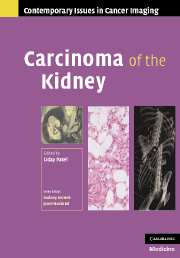Book contents
- Frontmatter
- Contents
- Contributors
- Series foreword
- Preface to Carcinoma of the Kidney
- 1 Renal cell cancer: overview and immunochemotherapy
- 2 Pathology of adult renal parenchymal cancers
- 3 Familial and inherited renal cancers
- 4 Radiological diagnosis of renal cancer
- 5 Staging of renal cancer
- 6 The case for biopsy in the modern management of renal cancer
- 7 Imaging characteristics of unusual renal cancers
- 8 Surgery for renal cancer: current status
- 9 Ablation of renal cancer
- 10 Post-treatment surveillance of renal cancer
- 11 Imaging for nephron-sparing procedures
- Index
- Plate Section
- References
11 - Imaging for nephron-sparing procedures
Published online by Cambridge University Press: 08 August 2009
- Frontmatter
- Contents
- Contributors
- Series foreword
- Preface to Carcinoma of the Kidney
- 1 Renal cell cancer: overview and immunochemotherapy
- 2 Pathology of adult renal parenchymal cancers
- 3 Familial and inherited renal cancers
- 4 Radiological diagnosis of renal cancer
- 5 Staging of renal cancer
- 6 The case for biopsy in the modern management of renal cancer
- 7 Imaging characteristics of unusual renal cancers
- 8 Surgery for renal cancer: current status
- 9 Ablation of renal cancer
- 10 Post-treatment surveillance of renal cancer
- 11 Imaging for nephron-sparing procedures
- Index
- Plate Section
- References
Summary
Introduction
The classic role of computed tomography (CT) and magnetic resonance (MR) in the imaging of a patient with a renal neoplasm is to characterize the lesion and stage malignant disease: assessing for adenopathy, renal vein tumor extension, adrenal involvement, and metastatic disease. Both CT and MR have a high degree of accuracy for lesion detection and characterization, but CT is the gold standard for detection, diagnosis, and staging of renal cell carcinoma because of high spatial resolution and widespread availability. Despite the fact that MR is more sensitive to contrast enhancement and different tissue types than CT, MR is often reserved for patients with a history of severe allergy to iodinated contrast and mild renal insufficiency. CT and MR are also frequently used to characterize simple and complex cystic renal masses and the criteria developed by Dr. Morton Bosniak have proved useful in stratifying their malignant potential. This stratification of risk based on CT or MR appearance serves as a guideline for management used by many clinicians.
The success of nephron-sparing surgery (NSS) in patients with the classic indications for partial nephrectomy such as a tumor in a patient who has undergone prior nephrectomy, or a patient with bilateral renal tumors or underlying renal parenchymal disease, has led to the expanded use of NSS to include elective indications such as renal masses less than 4 cm in patients without risk factors for renal insufficiency.
- Type
- Chapter
- Information
- Carcinoma of the Kidney , pp. 203 - 226Publisher: Cambridge University PressPrint publication year: 2007



